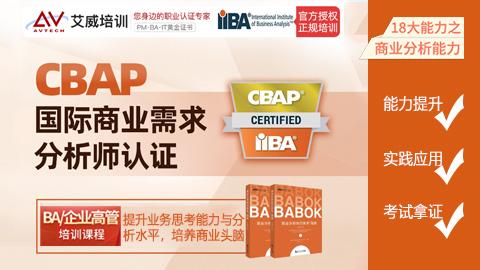笔记123
CBAP提升业务思考能力与分析水平,培养商业头脑。
Requirement Life cycle Management (Pg 42)
All about requirements/design
- 5.1 input Trace Requirement
Output Traced Requirement, Link to 7.5 Define Design Output.
- 5.2 Input Maintain Requirement
Output Maintained Requirements/ Design
- 5.3 Prioritize Requirements
Output Prioritised Requirements/ Design, Link to 6.3 Assess Risks
- 5.4 Assess Requirements Change, Might also involve proposed change
Output Assessment of Requirements and Design Change
- 5.5 Approve Requirement
Output Approved Requirements/ Designs
guidelines don't need remenber,
stakeholders do not need remenber, and techniques either.
key terms
information 3.0 now,but in the older 2.0 it was been definded needs
career
记忆-输入输出
使用观察法时,会存在霍桑效应(Hawthorne effect)。即是指在研究或观察中,被观察者因为知道自己正被关注而产生的行为改变。
几个图在学完全书之后再回来看
Tasks: is a discrete piece of work that may be performed formally or informally as
part of business analysis.
Each task in the BABOK Guide is presented in the following format: Purpose, Description
Inputs, Elements, Guidelines/Tools, Techniques, Stakeholders, Outputs.
Requirements Classification Schema:
• Business requirements: statements of goals, objectives, and outcomes that describe why a change has been initiated. They can apply to the whole of an enterprise, a business area, or a specific initiative.
• Stakeholder requirements: describe the needs of stakeholders that must be met in order to achieve the business requirements. They may serve as a bridge between business and solution requirements.
• Solution requirements: describe the capabilities and qualities of a solution that meets the stakeholder requirements. They provide the appropriate level of detail to allow for the development and implementation of the solution. Solution requirements can be divided into two sub-categories:
• functional requirements: describe the capabilities that a solution must have in terms of the behaviour and information that the solution will manage, and For more
information, see Non-Functional Requirements Analysis (p. 302).
• non-functional requirements or quality of service requirements: do not relate directly to the behaviour of functionality of the solution, but rather describe conditions under which a solution must remain effective or qualities that a solution must have.
• Transition requirements: describe the capabilities that the solution must have and the conditions the solution must meet to facilitate transition from the current state to the future state, but which are not needed once the change is complete. They are differentiated from other requirements types because they are of a temporary nature. Transition requirements address topics such as data conversion, training, and business continuity.
Requirements and design:
Needs (Problem Owener)
Requirements (Business Analyst)
Design (Implementation SMEs)
Solutions ()
The six core concepts in the BACCM are: Change, Need, Solution, Stakeholder,
Value, and Context.
Needs: A problem or opportunity to be addreeeed.
Change: The act of transformation in response to a need.
Contexts: The circumstances that influence, are inflienced by , and provide understanding of the change.
Solutions: A specific way of statisfying one or more needs in a context.
Stakeholdes: A group or individual with a relationship to the change, the need, or the solution.
Value: The worth, importance. or usefulness of something to a stakeholder within a context.
BA define what, not the one defining how.
What are the kinds of changes we are doing?
What are the needs we are trying to satisfy?
What are the solutions we are creating or changing?
Who are the stakeholders involved?
What do stakeholders consider to be of value?
What are the contexts that we and the solution are in?
Key terms:
Business Analysis information: the broad and diverse sets of information that business analysts analyze, transform, and report. It is information of any kind—at any level of detail—that is used as an input to, or is an output of,business analysis work.
Design: A design is a usable representation of a solution.
Requirements: A requirement is a usable representation of a need.
Enterprise: An enterprise is a system of one or more organizations and the solutions they useto pursue a shared set of common goals.
Organsization: An autonomous group of people under the management of a single individual or board, that works towards common goals and objectives.
Plan: A plan is a proposal for doing or achieving something.
Risk: Risk is the effect of uncertainty on the value of a change, a solution, or the enterprise.
Structure of the BABOK® Guide: Business Analyst Key Concept, Underlying Competencies, Techniques, Perspectives.
Content :Bussiness Analysis Key Concept, Knowledge Areas, Competencies, Techniques, Perspectives.
Key Concepts:
• Business Analysis Core Concept Model™ (BACCM™)
• Key Terms
• Requirements Classification Schema
• Stakeholders
• Requirements and Design
Knowledge Areas:
• Business Analysis Planning and Monitoring
• Elicitation and Collaboration
• Requirements Life Cycle Management:
• Strategy Analysis
• Requirements Analysis and Design Definition
• Solution Evaluation
Tasks: is a discrete piece of work that may be performed formally or informally as
part of business analysis.
Each task in the BABO Guide is presented in the following format: Purpose, Description
Inputs, Elements, Guidelines/Tools, Techniques, Stakeholders, Outputs.
Underlying competencies reflect knowledge, skills, behaviours, characteristics, and personal qualities that help one successfully perform the role of the business analyst.
Underlying competencies have the following structure:
Purpose
Definition
Effectiveness Measures
Techniques: provide additional information on ways that a task may be performed.
Techniques have the following structure:
Purpose
Description
Elements
Usage Considerations
Perspectives are used within business analysis work to provide focus to tasks and
techniques specific to the context of the initiative.
Perspectives have the following structure:
Change Scope
Business Analysis Scope
Methodologies, Approaches, and Techniques
Underlying Competencies
Impact on Knowledge Areas
A business analyst is any person who performs business analysis tasks described in
the BABOK® Guide, no matter their job title or organizational role.
Responsibility: discovering, synthesizing, and analyzing information from a variety of sources within an enterprise, including tools, processes,documentation, and stakeholders. eliciting the actual needs of stakeholders which frequently involves investigating and
clarifying their expressed desires in order to determine underlying issues and causes.
Business analysts play a role in aligning the designed and delivered solutions with
the needs of stakeholders.
IIBA Business Analysis Competency Model:
Generalist: Perform business analysis activities using a variety of techniques in initiatives of varying scope. (BA Techniques/Underlying Compentencies.)
Specialist: Perform business analysis activities using a more focused set of Teniques or a single methodology.
Hybrid: Requires some degree of competency in business analysis and contains an overlap of business analysis and another discipline.
Business Analysis Roles:
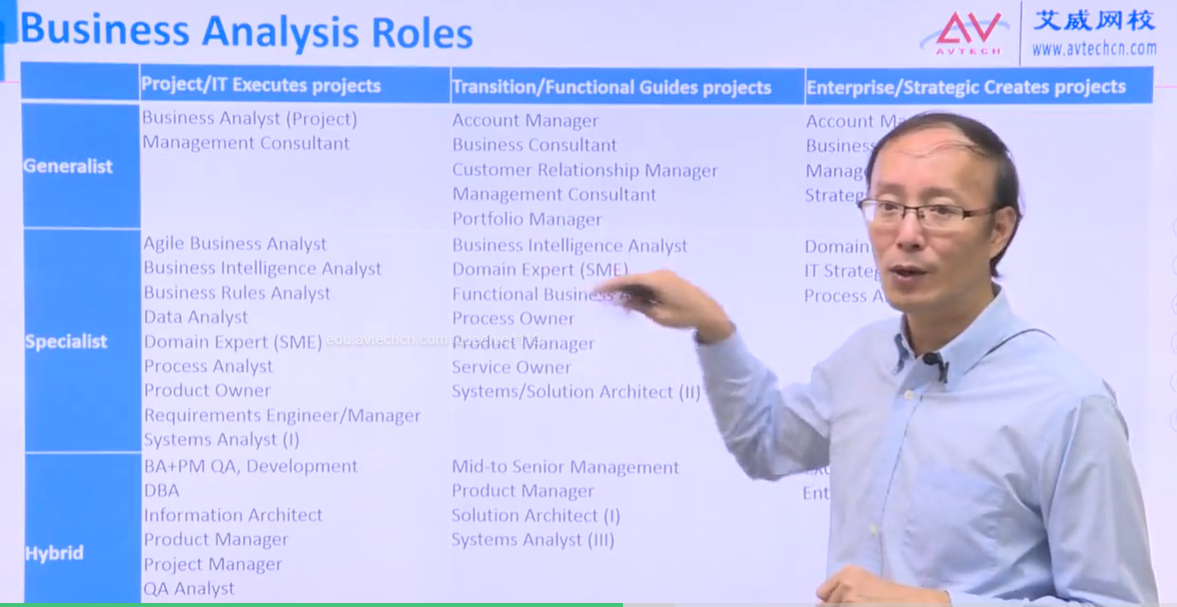
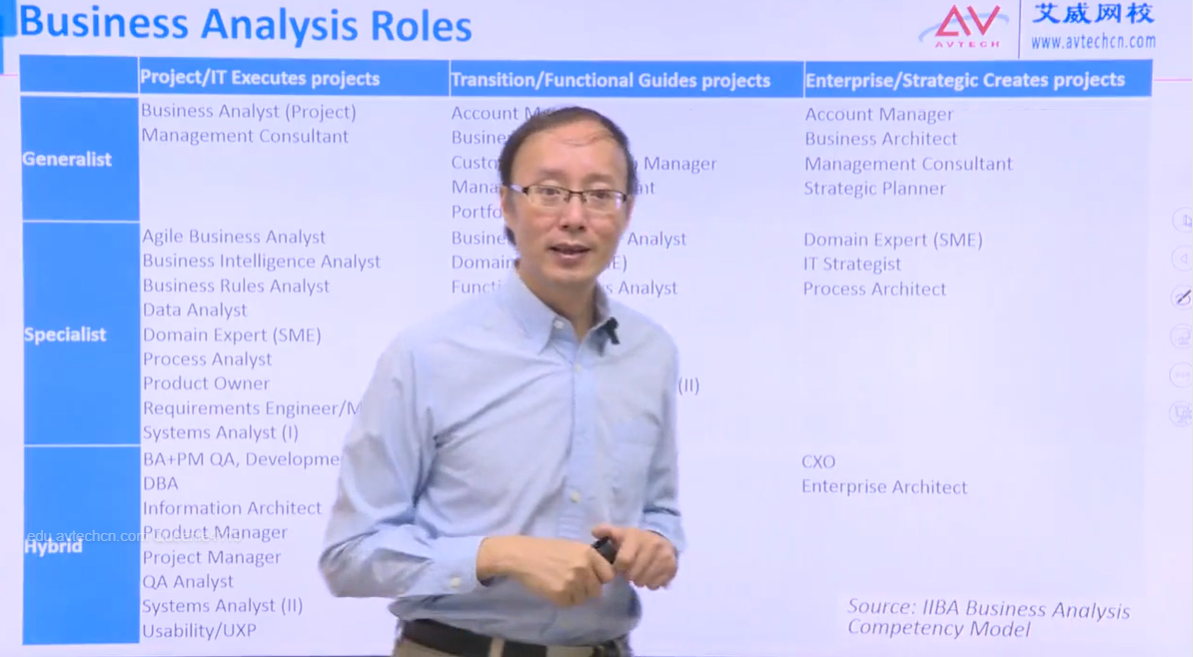
The six knowledge areas of the BABOK
Guide: Business Analysis Planning and
Monitoring, Elicitation and Collaboration, Requirements Life Cycle Management,
Strategy Analysis, Requirements Analysis and Design Definition (RADD), and Solution Evaluation.
Business analysis is the practise of enabling change in an enterprise by defining needs and recommending solutions that deliver value to stakeholders.
Initiatives: strategic, tactical, or operational. (program, protofilo)
perspectives: agile, business
intelligence, information technology, business architecture, and business process
management.
1.KPI:
indicator指标, 重要的指标是KPI, metric是指标的量化程度的特定时间点衡量, 特殊数字或阈值。
指标:要清楚有关经济适当可量化可信。可能多个指标一起配合。官僚化可能, 美化数值 。
2.文件分析: EL, 准备了解有什么文档- 文件分析回顾记录- 记录汇总发现。 利用现有资源成本低, 可以互相对比。
3. brainstorm- innovation new idea , in group 短时间多, 不考虑实施评价。
4.合作 product box , fishbowl ,affinity map 轻松揭露没发现的看法
5.focus group 针对现有产品搜集想法态度, 定性的, 预先挑选的参与人员, 了解用户态度想法
homogeneous背景一样
hetrogeneous背景不一样- 各种想法
准备-执行6-12 人参与人观察人moderator recorder, -记录
6.interview: structur- 先准备了问题- 省时间, 已经了解话题 unstructured没准备问题
准备目标要搜集的信息- 开放问题封闭问题。open ended questions。
7.observation - 复杂流程, 语言无法描述, 正在有的process。 不评判。第一手 信息。 头脑判断看不到
active - 可以打断 passive- 不打断
8.prototype-throw away 抛弃型原型 evolution function演进功能型。 POC
storyboard:场景做啥UX。
9.survey人多问题开放封闭-量化。 回收率低, 问题不清楚,
10.workshop 针对一个话题讨论达成一致做决定 。
facilitator不表态中立 scribe- groud rule focus 。 achive agreement in short time . feedback . 把所有人凑在一起很难。 人太多太少都不行
11.backlog management: 重要在上面优先级持续评估。 scrum project owner在敏捷里定义需求的方式。 用户故事描述因为没细节没文档所以信息会遗失
12.划分优先级
group : moscow 必须做, 可做可不做, 不用做。
ranking 重要度
timeboxing budget 迭代时间工作量
negotiation 和用户谈判
tradeoff
customer user ISME PM Sponsor Regulator
13.Business Rule- 日常的具体管理规则
policy - 宽泛的管理
定义规则definition rule 判断和计算消费1000是VIP, 加班9点后是加班
行为规则behavioral rule 所以是会违反的。 礼品不能超过50 美金
集中管理业务规则目录
14.Data dictionary ;meta data 库,对数据一致的了解
primitive : name alias value des
composite : sequence repetition 重复optional element 可选元素
15. 数据流图 data flow diagram 数据如何使用2 种类标记法fane-sarson /yourdon notation
discovery/verification tech ,业务层面分析,没有顺序!, 只有输入输出, 没有SH, 有外部实体
Context diagram
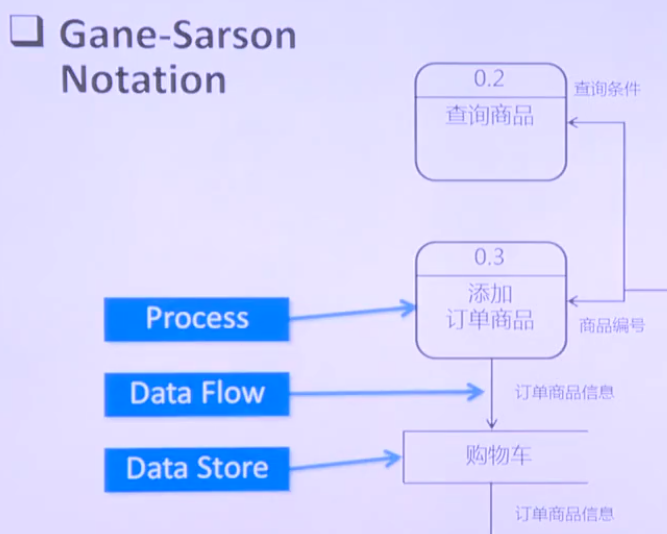
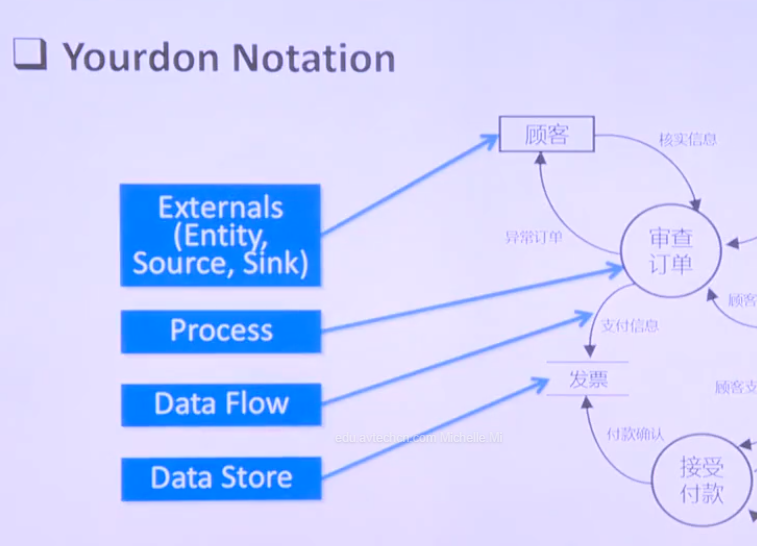
16.解决方案内的实体类data model : ERD实体关系图数据库, class 类图,
包含:entity class , att, relationship association (cardinality multipilicity 基数) , meta data 实体类属性关系
conceptual data model 概念模型- 业务领域

logical data model 解决方案设计
physical data model -实施
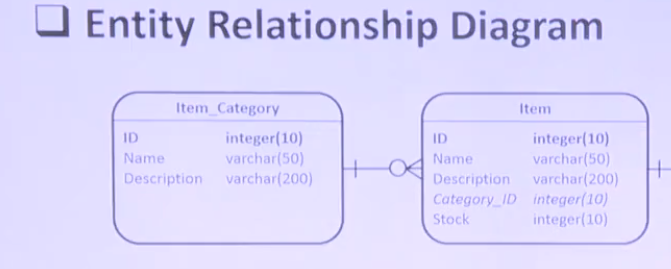
1对0-多
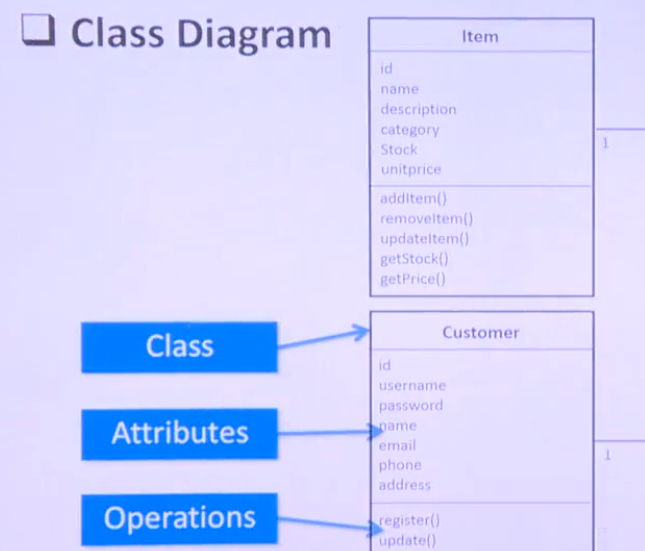
17.glossary专业术语大家都看的懂
18.interface接口分析, 可以在很早的时候去定义
系统接口表
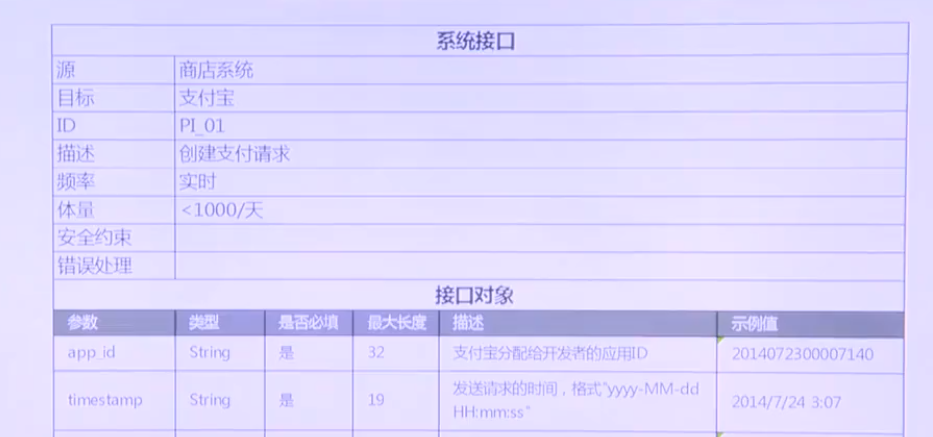
19.non functional
可用 兼容 功能 维护 性能 可移植性 可靠 容量可扩展scalability 增加用户 安全 易用usability 认知 本地化localization语言 SLA 扩展型extensibility
20.process model 按照顺序执行的活动
notation:VSM, UML, BPMA, IDEF
element :activity event directional flow role link decision point
activity diagram UML一个起始多个结束, 平行线同时进行的操作
图形描述容易理解, 不能发现流程瓶颈,太复杂流程不好
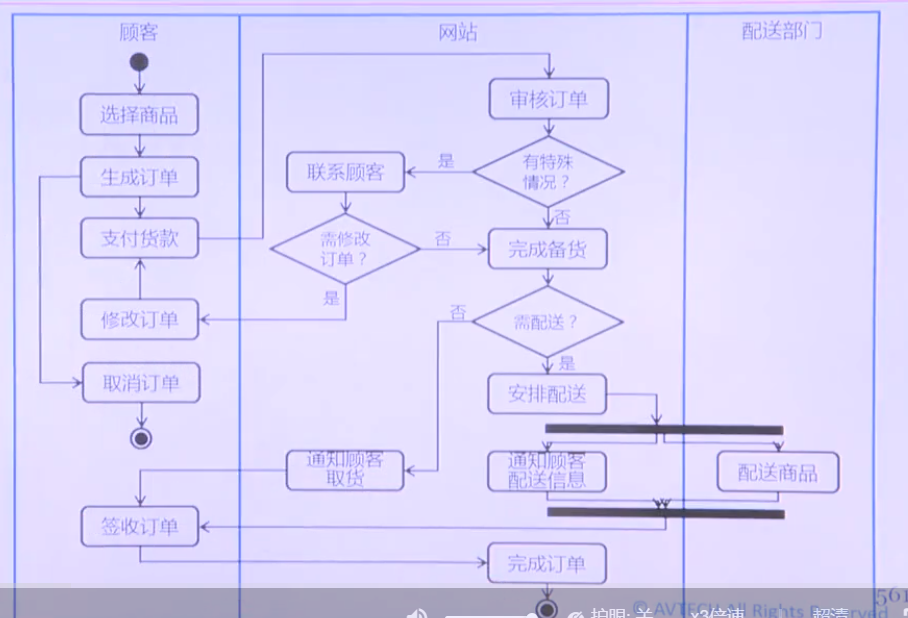
21.sequence 时序图- 系统内部之间活动
同步调用要等回来在做, 异步不用等
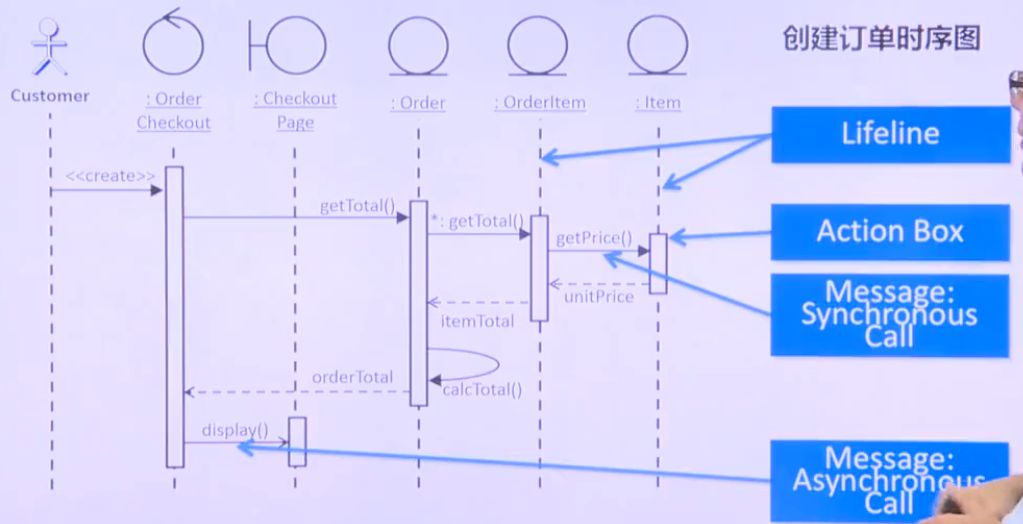
22.状态模型
23.use case senarios
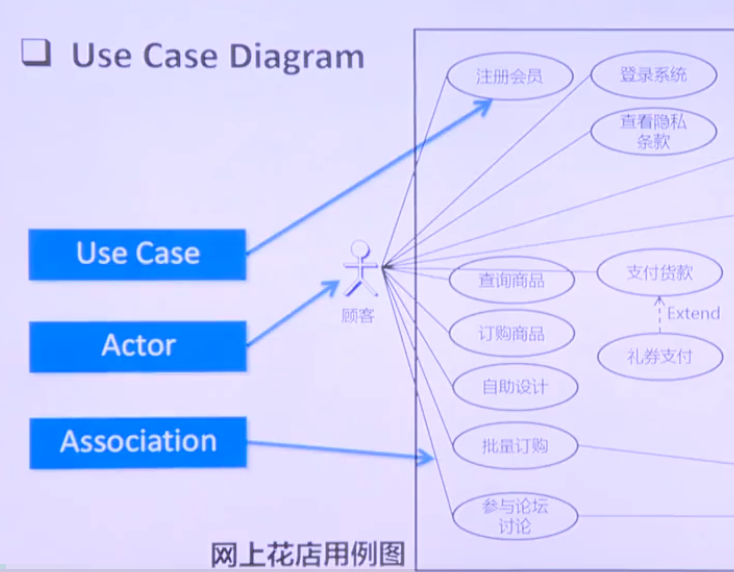
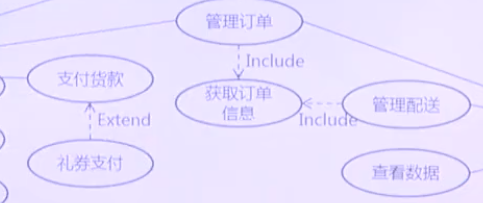
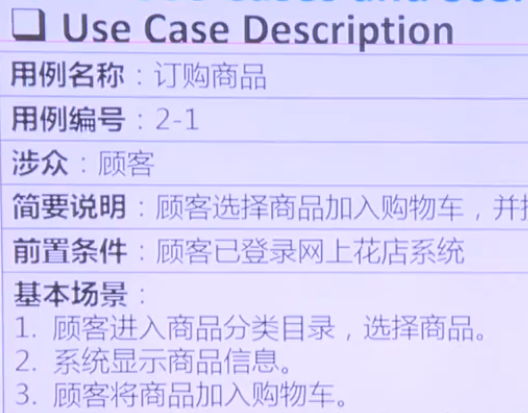
替代场景,异常场景,后置条件
24.用户故事: 谁干什么为什么who what why 优先级工作量可测试 应用小
25.review = inspection walkthrough reporstry desk check pass around adhoc
26.concept model 概念模型NV分类角色,容易沟通理解
27.root
false trail dead end
28.SWOT 有缺机会危险内外因素分析 SA
29.balance score 财务顾客流程成长 SA
30.decision model 决策信息知识 只用于复杂问题
31. risk analysis management
risk identification 可能性影响
avoid - transfer - mitifate - accept - increase
32.business case : need assessment - desired outcome - assess alternative - recommend solution 需求评估-期望结果-评估替代方案-建议解决方案 SA
33.决策分析
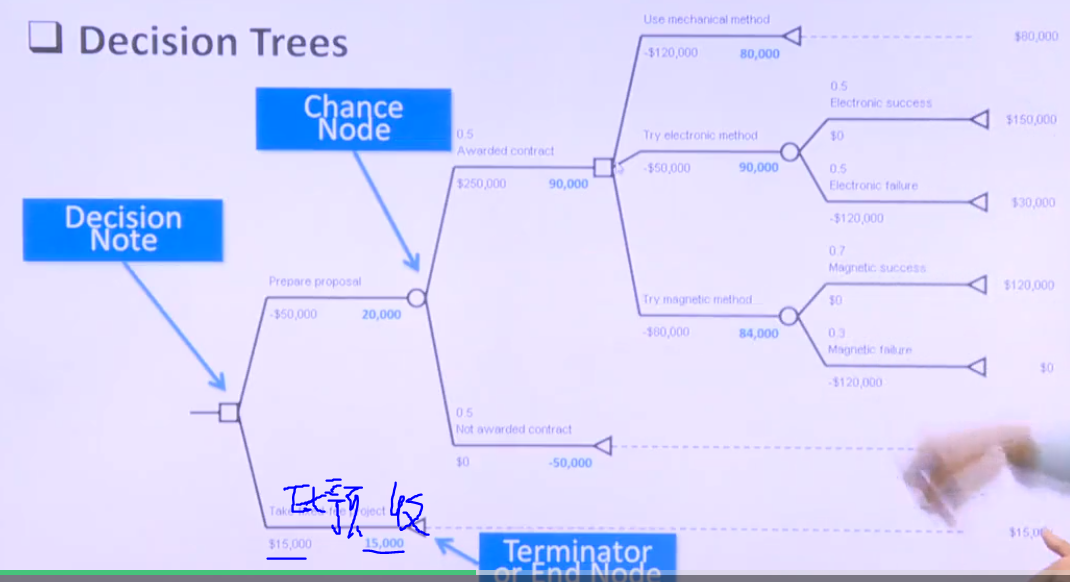
34.scope model 范围模型 in+out scope
context diagram系统交互图in+out scope外部实体和系统数据交互图也是数据流图data flow diagram
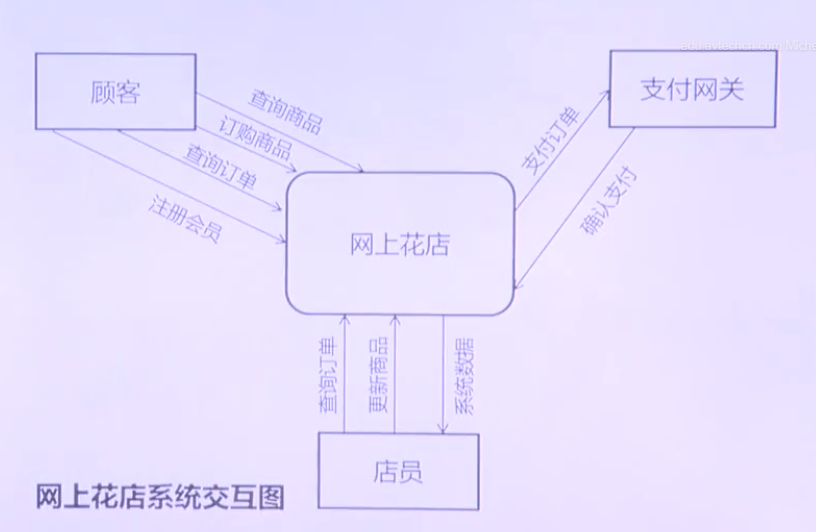
use case 也是范围模型in+out scope
35.
1.KPI:
indicator指标, 重要的指标是KPI, metric是指标的量化程度的特定时间点衡量, 特殊数字或阈值。
指标:要清楚有关经济适当可量化可信。可能多个指标一起配合。官僚化可能, 美化数值 。
2.文件分析: EL, 准备了解有什么文档- 文件分析回顾记录- 记录汇总发现。 利用现有资源成本低, 可以互相对比。
3. brainstorm- innovation new idea , in group 短时间多, 不考虑实施评价。
4.合作 product box , fishbowl ,affinity map 轻松揭露没发现的看法
5.focus group 针对现有产品搜集想法态度, 定性的, 预先挑选的参与人员, 了解用户态度想法
homogeneous背景一样
hetrogeneous背景不一样- 各种想法
准备-执行6-12 人参与人观察人moderator recorder, -记录
6.interview: structur- 先准备了问题- 省时间, 已经了解话题 unstructured没准备问题
准备目标要搜集的信息- 开放问题封闭问题。open ended questions。
7.observation - 复杂流程, 语言无法描述, 正在有的process。 不评判。第一手 信息。 头脑判断看不到
active - 可以打断 passive- 不打断
8.prototype-throw away 抛弃型原型 evolution function演进功能型。 POC
storyboard:场景做啥UX。
9.survey人多问题开放封闭-量化。 回收率低, 问题不清楚,
10.workshop 针对一个话题讨论达成一致做决定 。
facilitator不表态中立 scribe- groud rule focus 。 achive agreement in short time . feedback . 把所有人凑在一起很难。 人太多太少都不行
11.backlog management: 重要在上面优先级持续评估。 scrum project owner在敏捷里定义需求的方式。 用户故事描述因为没细节没文档所以信息会遗失
12.划分优先级
group : moscow 必须做, 可做可不做, 不用做。
ranking 重要度
timeboxing budget 迭代时间工作量
negotiation 和用户谈判
tradeoff
customer user ISME PM Sponsor Regulator
13.Business Rule- 日常的具体管理规则
policy - 宽泛的管理
定义规则definition rule 判断和计算消费1000是VIP, 加班9点后是加班
行为规则behavioral rule 所以是会违反的。 礼品不能超过50 美金
集中管理业务规则目录
14.Data dictionary ;meta data 库,对数据一致的了解
primitive : name alias value des
composite : sequence repetition 重复optional element 可选元素
15. 数据流图 data flow diagram 数据如何使用2 种类标记法fane-sarson /yourdon notation
discovery/verification tech ,业务层面分析,没有顺序!, 只有输入输出, 没有SH, 有外部实体


16.解决方案内的实体类data model : ERD实体关系图数据库, class 类图,
包含:entity class , att, relationship association (cardinality multipilicity 基数) , meta data 实体类属性关系
conceptual data model 概念模型- 业务领域

logical data model 解决方案设计
physical data model -实施

1对0-多

17.glossary专业术语大家都看的懂
18.interface接口分析, 可以在很早的时候去定义
系统接口表

19.non functional
可用 兼容 功能 维护 性能 可移植性 可靠 容量可扩展scalability 增加用户 安全 易用usability 认知 本地化localization语言 SLA 扩展型extensibility
20.process model 按照顺序执行的活动
notation:VSM, UML, BPMA, IDEF
element :activity event directional flow role link decision point
activity diagram UML一个起始多个结束, 平行线同时进行的操作
图形描述容易理解, 不能发现流程瓶颈,太复杂流程不好

21.sequence 时序图- 系统内部之间活动
同步调用要等回来在做, 异步不用等

22.状态模型
23.use case senarios



替代场景,异常场景,后置条件
24.用户故事: 谁干什么为什么who what why 优先级工作量可测试 应用小
25.review = inspection walkthrough reporstry desk check pass around adhoc
26.concept model 概念模型NV分类角色,容易沟通理解
27.root
false trail dead end
28.SWOT 有缺机会危险内外因素分析 SA
29.balance score 财务顾客流程成长 SA
30.decision model 决策信息知识 只用于复杂问题
31. risk analysis management
risk identification 可能性影响
avoid - transfer - mitifate - accept - increase
32.business case : need assessment - desired outcome - assess alternative - recommend solution 需求评估-期望结果-评估替代方案-建议解决方案 SA
33.决策分析

34.scope model 范围模型 in+out scope
context diagram系统交互图in+out scope外部实体和系统数据交互图也是数据流图data flow diagram

use case 也是范围模型in+out scope
35.
1.KPI:
indicator指标, 重要的指标是KPI, metric是指标的量化程度的特定时间点衡量, 特殊数字或阈值。
指标:要清楚有关经济适当可量化可信。可能多个指标一起配合。官僚化可能, 美化数值 。
2.文件分析: EL, 准备了解有什么文档- 文件分析回顾记录- 记录汇总发现。 利用现有资源成本低, 可以互相对比。
3. brainstorm- innovation new idea , in group 短时间多, 不考虑实施评价。
4.合作 product box , fishbowl ,affinity map 轻松揭露没发现的看法
5.focus group 针对现有产品搜集想法态度, 定性的, 预先挑选的参与人员, 了解用户态度想法
homogeneous背景一样
hetrogeneous背景不一样- 各种想法
准备-执行6-12 人参与人观察人moderator recorder, -记录
6.interview: structur- 先准备了问题- 省时间, 已经了解话题 unstructured没准备问题
准备目标要搜集的信息- 开放问题封闭问题。open ended questions。
7.observation - 复杂流程, 语言无法描述, 正在有的process。 不评判。第一手 信息。 头脑判断看不到
active - 可以打断 passive- 不打断
8.prototype-throw away 抛弃型原型 evolution function演进功能型。 POC
storyboard:场景做啥UX。
9.survey人多问题开放封闭-量化。 回收率低, 问题不清楚,
10.workshop 针对一个话题讨论达成一致做决定 。
facilitator不表态中立 scribe- groud rule focus 。 achive agreement in short time . feedback . 把所有人凑在一起很难。 人太多太少都不行
11.backlog management: 重要在上面优先级持续评估。 scrum project owner在敏捷里定义需求的方式。 用户故事描述因为没细节没文档所以信息会遗失
12.划分优先级
group : moscow 必须做, 可做可不做, 不用做。
ranking 重要度
timeboxing budget 迭代时间工作量
negotiation 和用户谈判
tradeoff
customer user ISME PM Sponsor Regulator
13.Business Rule- 日常的具体管理规则
policy - 宽泛的管理
定义规则definition rule 判断和计算消费1000是VIP, 加班9点后是加班
行为规则behavioral rule 所以是会违反的。 礼品不能超过50 美金
集中管理业务规则目录
14.Data dictionary ;meta data 库,对数据一致的了解
primitive : name alias value des
composite : sequence repetition 重复optional element 可选元素
15. 数据流图 data flow diagram 数据如何使用2 种类标记法fane-sarson /yourdon notation
discovery/verification tech ,业务层面分析,没有顺序!, 只有输入输出, 没有SH, 有外部实体


16.解决方案内的实体类data model : ERD实体关系图数据库, class 类图,
包含:entity class , att, relationship association (cardinality multipilicity 基数) , meta data 实体类属性关系
conceptual data model 概念模型- 业务领域

logical data model 解决方案设计
physical data model -实施

1对0-多

17.glossary专业术语大家都看的懂
18.interface接口分析, 可以在很早的时候去定义
系统接口表

19.non functional
可用 兼容 功能 维护 性能 可移植性 可靠 容量可扩展scalability 增加用户 安全 易用usability 认知 本地化localization语言 SLA 扩展型extensibility
20.process model 按照顺序执行的活动
notation:VSM, UML, BPMA, IDEF
element :activity event directional flow role link decision point
activity diagram UML一个起始多个结束, 平行线同时进行的操作
图形描述容易理解, 不能发现流程瓶颈,太复杂流程不好

21.sequence 时序图- 系统内部之间活动
同步调用要等回来在做, 异步不用等

22.状态模型
23.use case senarios


替代场景,异常场景,后置条件
24.用户故事: 谁干什么为什么who what why 优先级工作量可测试 应用小
25.review = inspection walkthrough reporstry desk check pass around adhoc
26.concept model 概念模型NV分类角色,容易沟通理解
27.root
false trail dead end
28.SWOT 有缺机会危险内外因素分析 SA
29.balance score 财务顾客流程成长 SA
30.decision model 决策信息知识 只用于复杂问题
31. risk analysis management
risk identification 可能性影响
avoid - transfer - mitifate - accept - increase
1.KPI:
indicator指标, 重要的指标是KPI, metric是指标的量化程度的特定时间点衡量, 特殊数字或阈值。
指标:要清楚有关经济适当可量化可信。可能多个指标一起配合。官僚化可能, 美化数值 。
2.文件分析: EL, 准备了解有什么文档- 文件分析回顾记录- 记录汇总发现。 利用现有资源成本低, 可以互相对比。
3. brainstorm- innovation new idea , in group 短时间多, 不考虑实施评价。
4.合作 product box , fishbowl ,affinity map 轻松揭露没发现的看法
5.focus group 针对现有产品搜集想法态度, 定性的, 预先挑选的参与人员, 了解用户态度想法
homogeneous背景一样
hetrogeneous背景不一样- 各种想法
准备-执行6-12 人参与人观察人moderator recorder, -记录
6.interview: structur- 先准备了问题- 省时间, 已经了解话题 unstructured没准备问题
准备目标要搜集的信息- 开放问题封闭问题。open ended questions。
7.observation - 复杂流程, 语言无法描述, 正在有的process。 不评判。第一手 信息。 头脑判断看不到
active - 可以打断 passive- 不打断
8.prototype-throw away 抛弃型原型 evolution function演进功能型。 POC
storyboard:场景做啥UX。
9.survey人多问题开放封闭-量化。 回收率低, 问题不清楚,
10.workshop 针对一个话题讨论达成一致做决定 。
facilitator不表态中立 scribe- groud rule focus 。 achive agreement in short time . feedback . 把所有人凑在一起很难。 人太多太少都不行
11.backlog management: 重要在上面优先级持续评估。 scrum project owner在敏捷里定义需求的方式。 用户故事描述因为没细节没文档所以信息会遗失
12.划分优先级
group : moscow 必须做, 可做可不做, 不用做。
ranking 重要度
timeboxing budget 迭代时间工作量
negotiation 和用户谈判
tradeoff
customer user ISME PM Sponsor Regulator
13.Business Rule- 日常的具体管理规则
policy - 宽泛的管理
定义规则definition rule 判断和计算消费1000是VIP, 加班9点后是加班
行为规则behavioral rule 所以是会违反的。 礼品不能超过50 美金
集中管理业务规则目录
14.Data dictionary ;meta data 库,对数据一致的了解
primitive : name alias value des
composite : sequence repetition 重复optional element 可选元素
15. 数据流图 data flow diagram 数据如何使用2 种类标记法fane-sarson /yourdon notation
discovery/verification tech ,业务层面分析,没有顺序!, 只有输入输出, 没有SH, 有外部实体


16.解决方案内的实体类data model : ERD实体关系图数据库, class 类图,
包含:entity class , att, relationship association (cardinality multipilicity 基数) , meta data 实体类属性关系
conceptual data model 概念模型- 业务领域

logical data model 解决方案设计
physical data model -实施

1对0-多

17.glossary专业术语大家都看的懂
18.interface接口分析, 可以在很早的时候去定义
系统接口表

19.non functional
可用 兼容 功能 维护 性能 可移植性 可靠 容量可扩展scalability 增加用户 安全 易用usability 认知 本地化localization语言 SLA 扩展型extensibility
20.process model 按照顺序执行的活动
notation:VSM, UML, BPMA, IDEF
element :activity event directional flow role link decision point
activity diagram UML一个起始多个结束, 平行线同时进行的操作
图形描述容易理解, 不能发现流程瓶颈,太复杂流程不好

21.sequence 时序图- 系统内部之间活动
同步调用要等回来在做, 异步不用等

22.状态模型
23.use case senarios


替代场景,异常场景,后置条件
24.用户故事: 谁干什么为什么who what why 优先级工作量可测试 应用小
25.review = inspection walkthrough reporstry desk check pass around adhoc
26.concept model 概念模型NV分类角色,容易沟通理解
27.root
false trail dead end
28.SWOT 有缺机会危险内外因素分析 SA
29.balance score 财务顾客流程成长 SA
30.decision model 决策信息知识
1.KPI:
indicator指标, 重要的指标是KPI, metric是指标的量化程度的特定时间点衡量, 特殊数字或阈值。
指标:要清楚有关经济适当可量化可信。可能多个指标一起配合。官僚化可能, 美化数值 。
2.文件分析: EL, 准备了解有什么文档- 文件分析回顾记录- 记录汇总发现。 利用现有资源成本低, 可以互相对比。
3. brainstorm- innovation new idea , in group 短时间多, 不考虑实施评价。
4.合作 product box , fishbowl ,affinity map 轻松揭露没发现的看法
5.focus group 针对现有产品搜集想法态度, 定性的, 预先挑选的参与人员, 了解用户态度想法
homogeneous背景一样
hetrogeneous背景不一样- 各种想法
准备-执行6-12 人参与人观察人moderator recorder, -记录
6.interview: structur- 先准备了问题- 省时间, 已经了解话题 unstructured没准备问题
准备目标要搜集的信息- 开放问题封闭问题。open ended questions。
7.observation - 复杂流程, 语言无法描述, 正在有的process。 不评判。第一手 信息。 头脑判断看不到
active - 可以打断 passive- 不打断
8.prototype-throw away 抛弃型原型 evolution function演进功能型。 POC
storyboard:场景做啥UX。
9.survey人多问题开放封闭-量化。 回收率低, 问题不清楚,
10.workshop 针对一个话题讨论达成一致做决定 。
facilitator不表态中立 scribe- groud rule focus 。 achive agreement in short time . feedback . 把所有人凑在一起很难。 人太多太少都不行
11.backlog management: 重要在上面优先级持续评估。 scrum project owner在敏捷里定义需求的方式。 用户故事描述因为没细节没文档所以信息会遗失
12.划分优先级
group : moscow 必须做, 可做可不做, 不用做。
ranking 重要度
timeboxing budget 迭代时间工作量
negotiation 和用户谈判
tradeoff
customer user ISME PM Sponsor Regulator
13.Business Rule- 日常的具体管理规则
policy - 宽泛的管理
定义规则definition rule 判断和计算消费1000是VIP, 加班9点后是加班
行为规则behavioral rule 所以是会违反的。 礼品不能超过50 美金
集中管理业务规则目录
14.Data dictionary ;meta data 库,对数据一致的了解
primitive : name alias value des
composite : sequence repetition 重复optional element 可选元素
15. 数据流图 data flow diagram 数据如何使用2 种类标记法fane-sarson /yourdon notation
discovery/verification tech ,业务层面分析,没有顺序!, 只有输入输出, 没有SH, 有外部实体


16.解决方案内的实体类data model : ERD实体关系图数据库, class 类图,
包含:entity class , att, relationship association (cardinality multipilicity 基数) , meta data 实体类属性关系
conceptual data model 概念模型- 业务领域

logical data model 解决方案设计
physical data model -实施

1对0-多

17.glossary专业术语大家都看的懂
18.interface接口分析, 可以在很早的时候去定义
系统接口表

19.non functional
可用 兼容 功能 维护 性能 可移植性 可靠 容量可扩展scalability 增加用户 安全 易用usability 认知 本地化localization语言 SLA 扩展型extensibility
20.process model 按照顺序执行的活动
notation:VSM, UML, BPMA, IDEF
element :activity event directional flow role link decision point
activity diagram UML一个起始多个结束, 平行线同时进行的操作
图形描述容易理解, 不能发现流程瓶颈,太复杂流程不好

21.sequence 时序图- 系统内部之间活动
同步调用要等回来在做, 异步不用等

22.状态模型
23.use case senarios


替代场景,异常场景,后置条件
24.用户故事: 谁干什么为什么who what why 优先级工作量可测试 应用小
25.review = inspection walkthrough reporstry desk check pass around adhoc
26.concept model 概念模型NV分类角色,容易沟通理解
27.root
false trail dead end
28.SWOT 有缺机会危险内外因素分析
29.
30.
1.KPI:
indicator指标, 重要的指标是KPI, metric是指标的量化程度的特定时间点衡量, 特殊数字或阈值。
指标:要清楚有关经济适当可量化可信。可能多个指标一起配合。官僚化可能, 美化数值 。
2.文件分析: EL, 准备了解有什么文档- 文件分析回顾记录- 记录汇总发现。 利用现有资源成本低, 可以互相对比。
3. brainstorm- innovation new idea , in group 短时间多, 不考虑实施评价。
4.合作 product box , fishbowl ,affinity map 轻松揭露没发现的看法
5.focus group 针对现有产品搜集想法态度, 定性的, 预先挑选的参与人员, 了解用户态度想法
homogeneous背景一样
hetrogeneous背景不一样- 各种想法
准备-执行6-12 人参与人观察人moderator recorder, -记录
6.interview: structur- 先准备了问题- 省时间, 已经了解话题 unstructured没准备问题
准备目标要搜集的信息- 开放问题封闭问题。open ended questions。
7.observation - 复杂流程, 语言无法描述, 正在有的process。 不评判。第一手 信息。 头脑判断看不到
active - 可以打断 passive- 不打断
8.prototype-throw away 抛弃型原型 evolution function演进功能型。 POC
storyboard:场景做啥UX。
9.survey人多问题开放封闭-量化。 回收率低, 问题不清楚,
10.workshop 针对一个话题讨论达成一致做决定 。
facilitator不表态中立 scribe- groud rule focus 。 achive agreement in short time . feedback . 把所有人凑在一起很难。 人太多太少都不行
11.backlog management: 重要在上面优先级持续评估。 scrum project owner在敏捷里定义需求的方式。 用户故事描述因为没细节没文档所以信息会遗失
12.划分优先级
group : moscow 必须做, 可做可不做, 不用做。
ranking 重要度
timeboxing budget 迭代时间工作量
negotiation 和用户谈判
tradeoff
customer user ISME PM Sponsor Regulator
13.Business Rule- 日常的具体管理规则
policy - 宽泛的管理
定义规则definition rule 判断和计算消费1000是VIP, 加班9点后是加班
行为规则behavioral rule 所以是会违反的。 礼品不能超过50 美金
集中管理业务规则目录
14.Data dictionary ;meta data 库,对数据一致的了解
primitive : name alias value des
composite : sequence repetition 重复optional element 可选元素
15. 数据流图 data flow diagram 数据如何使用2 种类标记法fane-sarson /yourdon notation
discovery/verification tech ,业务层面分析,没有顺序!, 只有输入输出, 没有SH, 有外部实体


16.解决方案内的实体类data model : ERD实体关系图数据库, class 类图,
包含:entity class , att, relationship association (cardinality multipilicity 基数) , meta data 实体类属性关系
conceptual data model 概念模型- 业务领域

logical data model 解决方案设计
physical data model -实施

1对0-多

17.glossary专业术语大家都看的懂
18.interface接口分析, 可以在很早的时候去定义
系统接口表

19.non functional
可用 兼容 功能 维护 性能 可移植性 可靠 容量可扩展scalability 增加用户 安全 易用usability 认知 本地化localization语言 SLA 扩展型extensibility
20.process model 按照顺序执行的活动
notation:VSM, UML, BPMA, IDEF
element :activity event directional flow role link decision point
activity diagram UML一个起始多个结束, 平行线同时进行的操作
图形描述容易理解, 不能发现流程瓶颈,太复杂流程不好

21.sequence 时序图- 系统内部之间活动
同步调用要等回来在做, 异步不用等

22.状态模型
23.use case senarios


替代场景,异常场景,后置条件
24.用户故事: 谁干什么为什么who what why 优先级工作量可测试 应用小
25.review = inspection walkthrough reporstry desk check pass around adhoc
26.
27.
28.
29.
30.

